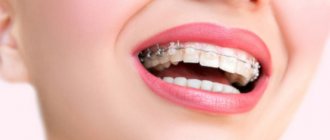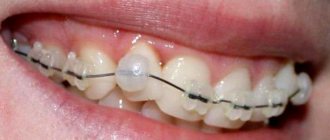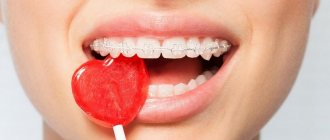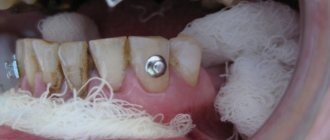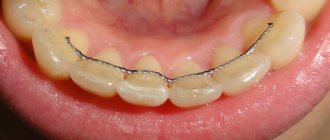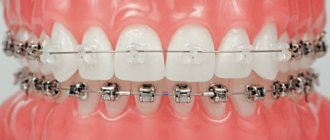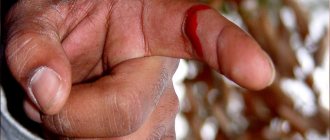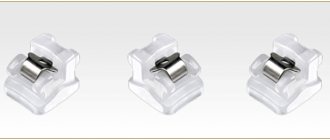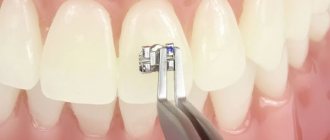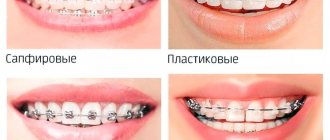Types of Dental Adhesive
Glue for braces, otherwise called adhesive, can be purchased in bottles or syringes and is white, clear or colored.
Colored adhesive helps the dentist to see all the residue after the installation is completed and, accordingly, remove any excess. Its characteristic feature is the ability to become colorless after hardening, which is especially important for those patients who prefer transparent braces with artificial sapphires. Buying the substance on your own will not be a good solution; this should be left to the orthopedist treating the patient. The reason is that not every product is suitable for one or another design; without knowing the type of your system and its features, it is easy to make a mistake with your choice.
Glue for braces also differs in its hardening speed; there may be options with fast and slow polymerization. If the system installation procedure takes a long time, then a substance with slow hardening becomes an excellent solution; if everything is done faster, then the appropriate glue is used.
Content
- The impact of malocclusion on health
- Making a choice
- Removable type of braces for adults
- Popular braces
- What is a retainer?
- Systems for teenagers
- For children
- Do your teeth hurt during treatment?
- How to care for your oral cavity?
- Pain after removal
A beautiful smile can work wonders.
People who regularly show their teeth are more successful in life than those who don't. But what to do if nature has not given you the opportunity to smile? The most common reason for this is uneven teeth. A person becomes unsure of himself and begins to communicate less with people. In a word, he develops an inferiority complex. But there is a solution to this problem. Medicine is developing rapidly, and now anyone can get dental braces. With their help you can correct your bite. Moreover, this can be done quite quickly. For example, advanced cases take five years - this is exactly the period required to straighten the teeth.
But not everyone decides to get braces. Why? The fact is that most people are subject to stereotypes. Malocclusion occurs in 70% of the world's population. And what part of them do you think undergo treatment with braces? Less than half! And all because they consider it ineffective and painful. But that's not true.
After all, modern orthodontics offers a huge variety of designs that have different effects on teeth and look different. People who are involved in public life are often concerned about aesthetic issues. This is due to the fact that they have to interact with more people, which will be more difficult to do with designs that, in their opinion, are repulsive. As we have already said, there are different types of braces systems, and one of them is ceramic. It is white in color, so it easily “adjusts” to the natural color of the teeth.
Preparing for positioning
The patient is not required to independently perform specialized preparatory measures several days before installation. In the chosen clinic, dentists will carry out all the necessary procedures; it is only important to sit calmly and composedly in the chair.
It will take the doctor a lot of time to thoroughly prepare the patient's mouth.
The preparatory stage begins with consultation with a specialist. The doctor studies the problem and begins to improve the health of all elements of the dentition.
Oral preparation requires the following steps:
- Elimination of carious lesions. It is important to treat all areas damaged by caries.
- Assessment of the condition of old filling material. Old and worn fillings that are crumbling or have a weak structure must be replaced.
- Treatment of periodontal diseases. The periodontal tissues and mucous membranes must be in absolutely healthy condition. Even sluggish and non-aggressive inflammatory processes can cause a lot of trouble after fixing the braces system.
- Restoration of tooth enamel. Remineralization of enamel allows you to avoid the development of a number of diseases during the correction stages. It is better to increase its protective functions during preparation;
- Professional teeth cleaning.
Once all the preparations have been made, the doctor can discuss with the patient the optimal method of attaching orthodontic brackets.
The choice of fixation method is the prerogative of the orthodontist, that is, his right, justified by the presence of certain knowledge and skills. Therefore, it is better to trust a doctor in this matter.
The impact of malocclusion on health
Malocclusion has a negative impact on human health. We don’t think it’s worth talking about the aesthetic component. Of course, there are no life-threatening indicators, but it is still necessary to get rid of the anomaly, otherwise it will lead to disastrous consequences. First of all, the impact falls on the gastrointestinal tract. This happens due to the fact that a person’s chewing function is impaired. Correcting your bite with braces will help you avoid digestive problems. There are just some contraindications for installation:
- infectious diseases of the oral cavity;
- different sizes of teeth;
- allergies (occurs extremely rarely to metal, but in this case it is possible to install, for example, ceramic structures).
Characteristics of glue for braces
- hypoallergenic,
- resistance to external influences,
- ensuring reliable fixation - the glue must be such that the bracket is fixed securely throughout the entire period of treatment and at the same time allows for easy removal of the plates without damaging the tooth enamel,
- ease of application,
- fast hardening,
- wide availability - it is important that the orthodontist can easily purchase it to fix the bracket in case it comes off.
Without special glue, it is not possible to fix braces on the teeth. It is this that ensures reliable fastening of the system throughout the entire period of orthodontic treatment.
High-quality glue should contain useful microelements, in particular fluoride, which will prevent the development of caries under braces.
During the treatment period, some adhesive may be required in case the bracket becomes detached from the surface of the teeth. Therefore, it is necessary to choose a large clinic where consumables will always be available so that prompt adjustment of the brace system can be carried out.
Adhesive adhesive, as a rule, is supplied with braces, that is, its composition is developed by the manufacturer for a specific system - depending on its characteristics, the type of base of the plates, as well as the material used (ceramics, sapphires, composites or metal). It is important to check with your doctor whether the original adhesive produced by a well-known company is used, since the degree of fixation of the bracket system on the teeth directly depends on its quality and you should not skimp on it.
In terms of its characteristics, glue for braces differs in many ways from traditional glue, in particular, its key parameters will be:
- Resistance to various external influences.
- High degree of reliability of fastening bracket systems.
- Ease of use and application.
- Availability in specialized stores.
- The absence of harmful components in its composition.
It comes complete with the design; without it, reliable fixation of the system on the patient’s teeth is not possible. But it should be remembered that you must use only the original product; only in this case can we talk about guaranteed and reliable fixation.
Features of the metal brace system
Any braces system is a non-removable device that is firmly fixed to the teeth and is intended for the correction of orthodontic disorders. The effect that develops through the use of this design is due to the mechanical pressure that it exerts on the teeth, forcing them to move in the required direction. Under the influence of the applied force, the alignment of the dentition occurs.
The main components of the braces system are a rigid arch and clasps, the braces themselves, which are designed to secure the arch to the tooth surface. The remaining elements are additional, contributing to the integration of all components into a common, coherently functioning system.
If the arc is always made of durable steel or its alloys, then the locks are made of different materials. This allows you to highlight aesthetic models. These include ceramic and sapphire braces. There are also metal braces, the material of which is steel.
Indirect installation
The algorithm of actions for the direct method follows from the name itself, that is, braces are installed directly on the dental units, and on each one separately.
All clasps have visible differences - after all, some are made for incisors, others for molars, etc.
Studying the panoramic image, the doctor installs braces on each tooth, following a certain sequence. Such work can rightfully be called creative.
The procedure begins with the installation of a special device - a rubber dam, which ensures asepsis and dryness of the work area. To allow the dentist unimpeded access to the surface of the teeth, the lips and cheeks are isolated from the dentition using a retractor, which is also capable of restraining the mobility of the tongue.
At the end of the listed activities, the protective layer of the units must be processed. To do this, perform the following manipulations:
- grinding using abrasive tools;
- washing with hydrogen peroxide;
- dry for 60 seconds;
- etching with a paste-like substance based on orthophosphoric acid (no more than 1 minute). This makes the surface porous, which ensures deep penetration of the adhesive and guarantees strong fixation;
- rinsing teeth with strong water pressure;
- suction of liquid and decay products with a dental aspirator;
- drying the working surface with air that is under some pressure;
- immediate application of a composite to the surface of the units, which makes it possible to contain the negative effects of salivary gland secretions.
Next begins the most important stage - installing braces. To begin, the doctor prepares an adhesive composition. As a rule, doctors in Russian clinics prefer two-component formulations.
The mixture is applied to the back of the lock. Fixation is performed on a precisely defined area of the crown. To press the bracket well, special fixing clamps are used. The actions are repeated on all other elements of the dentition.
For reference! The duration of the procedure is about 2 hours. The adhesive composition completely hardens after 24 hours, after which the component elements of the system are installed.
In everyday practice, orthodontists most often use direct bonding, but achieving an ideal result with such an installation is difficult.
It is important to achieve precise positioning of the plate on the tooth, which is what doctors are trying to do with the help of various devices. Despite this, the human factor and the bacterial environment of the oral cavity negatively affect the reliability of fixation of the brackets.
In addition, the traditional method of bonding is considered labor-intensive and difficult to perform not only for the dentist, but also for the patient.
But there is also an advantage - if the need arises, you can adjust the initial fixation scheme and control the fastening of each element of the orthodontic system.
The video shows the process of positioning braces using the direct method.
This technique was introduced into the dental industry quite recently and has become an alternative option to long and painstaking work with single locks.
All brackets are fixed simultaneously using a mouth guard. This device makes it possible to glue brackets with high precision and minimize the patient’s time in the clinic.
The sequence of application of the indirect technique:
- taking a plaster impression of the patient’s teeth;
- production of accurate models of both jaws;
- marking areas on the model for future fastening of the plates (the doctor draws horizontal and vertical stripes as a guide);
- real brackets are attached to the dental model (the adhesive is caramelized sugar);
- the model is processed with special material;
- the brackets are pressed in;
- the adhesive composition is washed away and the lining hardens;
- removing the plates along with the frozen material;
- manufacturing a mouthguard that exactly copies the features of the dentition along with fixed braces;
- installing a mouthguard on the patient’s dentition;
- introduction of a special composition for etching enamel into specially created holes;
- removing the cover;
- washing and drying of units;
- fixation of braces in a mouth guard;
- treating the back surface with glue;
- re-installation of the mouthguard on the dental units until the adhesive composition has completely hardened (60 min.).
It is important to note that during attachment the mouthguard can be cut into several parts. This will allow you to constantly control the process of installing and removing the lining without the risk of damaging the bracket.
Here's another little trick: to fix and remove the lining without any problems, you can hold the plates with a scaler.
Indirect bonding is characterized by minimal tension and high precision in comparison with the previous technique. A plaster model can be assessed from any angle, and an erroneously determined point for the location of individual elements can be changed at any time.
Let's look at the many advantages of this tactic:
- simultaneous installation of each of the braces;
- reduced procedure time;
- minimal patient discomfort;
- extreme fixation accuracy;
- consistent and accurate results;
- “surprises” during the correction are excluded;
- almost complete absence of painful bends, which makes treatment as comfortable as possible.
The only drawback of this method is the wait for the production of a plaster model, a mouth guard and the entire orthodontic structure. After all, not every patient wants to spend his personal time on this.
In the video, watch how braces systems are installed indirectly.
To install braces, there is a basic standard protocol for direct fixation of oral braces, which is very common in Russia - braces are glued “by eye” without carefully checking its position, which is easier and faster for a specialist.
The expert group of orthodontists at the Confidence clinic uses a progressive protocol for fixing braces based on the best techniques of recognized Italian and French specialists in orthodontics. The key feature of this protocol is indirect fixation, which has obvious advantages in terms of accuracy and patient comfort.
Indirect fixation is the most progressive method now, which is already actively used by European orthodontists. When the doctor has a model of the patient’s teeth in his hands, and before his eyes are his pictures and photographs, the doctor has the opportunity to impeccably accurately outline each tooth, mark all the axes on it and place the bracket in the most correct position.
Systems for teenagers
Orthodontics in Moscow continues to constantly develop. Anyone can correct their bite, and it is best to do it in childhood or adolescence. And which dental braces to choose, the price of which will be optimal, but at the same time the designs will perfectly perform their functional duties? Here we must be guided by the peculiarities occurring in the body of a teenager.
At this age, a person has a lack of calcium and fluoride. Teenagers often bite their nails, chew gum, and have many other bad habits that lead to a crooked bite. And due to the lack of microelements important for teeth in the body, a person at this age can easily develop an anomaly.
If these indications for treatment exist, the teenager needs to have braces installed on his teeth (the cost of each system varies):
- there are gaps between the teeth;
- the dentition is crooked;
- there is an urgent need for treatment.
Bracket systems are installed, the cost of which depends on their material of manufacture and much more, in several stages. If treatment is required for a child under nine years of age, the doctor performs the procedure and then monitors the child for several years. Then the installation of other braces is carried out during adolescence. The need for this is due to the growth of the jaw.
To make a choice in favor of one or another braces, you need to familiarize yourself with the advantages and disadvantages of each of them. Let's start with metal ones. Such lower and upper braces have the following advantages:
- small thickness;
- quite comfortable to wear;
- the mucous membrane is not injured;
- ease of care;
- strength;
- durability;
- low cost.
As you can see, such a brace system has many advantages; the price in this case is one of the main advantages. But there is one drawback - unaesthetic.
Products made from composite material are quite fragile and therefore short-lived. Ceramic, on the contrary, are highly durable. At the same time, they are aesthetically pleasing, as they are invisible to the eye and are firmly attached to the enamel. But the prices for such braces (Moscow) are quite high. It is also worth noting that they are not picky in their care: you need to look after them very carefully.
Lingual braces, as we have already said, have many advantages. But they can only be installed by adults. The fact is that they are attached to the inside of the teeth, which is an undeniable advantage, but they take a long time to get used to, so teenagers should not use them.
Methods of installation and fastening of structures
After the end of the preparatory period, the doctor decides on the format of the main stage of work. Dentists distinguish between two installation methods: direct and indirect.
Choosing this method involves manually fixing the locks to each tooth. Such work requires not only a lot of patience and time, but also the experience of an orthodontist. Since teeth have different shapes and sizes, the fasteners must be fixed in the correct location on the surface of the tooth enamel.
The work algorithm is as follows:
- Installation of the retractor.
- To improve adhesion, a special composition is applied to the tooth surface. Phosphoric acid roughens the enamel, which helps fix the clasps more securely on the tooth surface.
- After 25-30 seconds, the solution is washed off, the surface can be dried with a stream of warm air.
- To form protection, a composite is applied to the enamel.
- The ingredients to prepare the glue are mixed.
- The composition is applied to the inside of the clasps.
- The clasps are alternately fixed on the teeth.
- Remains of glue protruding from under the clasps are carefully removed.
- After checking the reliability of gluing, a metal arc of the required rigidity and ligature is inserted into the locks.
The glue hardens in about a day, and the installation procedure takes about 1.5 hours. On the first day, patients are recommended to take exclusively liquid and soft foods.
Advantages and disadvantages
The advantages include:
- reliability of fixation;
- impossibility of food getting into the space between the tooth and the clasp;
- possibility of adjustments during installation;
- fastening accuracy.
Dentists consider the painstaking and lengthy work to be a disadvantage. In addition, the patient is required to sit motionless in the chair the entire time the dentist is working.
This method is faster, since the clasps of the braces are fixed together using a special mouthguard. Indirect installation takes less time in the dentist's office, but requires longer fabrication in a laboratory setting.
Preparing to install the system includes several steps:
- Taking impressions.
- Making a plaster model.
- Marking on the plaster model of the jaw where the clasps are attached.
- Making a custom mouthguard.
- Trying on locks on a model.
The installation process in the oral cavity is almost identical to the direct method, with the only difference: the dentist does not glue the clasps manually, but attaches them to the surface of the units with one push of the mouthguard.
Pros and cons of the technique
Among the advantages, doctors note the speed of installation and patient comfort during the procedure.
The disadvantages include the difficulty of controlling each individual clasp, the lengthy preparation process and the difficulty of removing residual adhesive composition.
The installation methods indicated are the experience of dentists. However, in addition to experience, there is a protocol for the correct selection and fixation of orthodontic structures.
Using measurements of the length of the tooth crown and comparing the obtained data according to the Pitts table helps dentists avoid possible mistakes when selecting a system for correcting dental pathologies.
The installation point of the bracket bracket is calculated as follows:
- Unit crown length measurement.
- Search for the result obtained in the GPS-A column.
- The installation height is visible in the cross line.
Upper jaw
| GPS-A | 1 | 2 | 3 | 4 | 5 | 6 | 7 |
| 8 | 4 | 4 | 4,5 | 4,5 | 4 | 3 | 3 |
| 9 | 4,5 | 4,5 | 5 | 5 | 4,5 | 3,5 | 3,5 |
| 10 | 5 | 5 | 5,5 | 5,5 | 5 | 4 | 4 |
| 11 | 5 | 5 | 6 | 6 | 5,5 | 4,5 | 4,5 |
Lower jaw
| GPS-A | 1 | 2 | 3 | 4 | 5 | 6 | 7 |
| 9 | 5 | 4,5 | 4,5 | 4 | 3,5 | 2,5 | 2 |
| 10 | 5,5 | 5 | 5 | 4,5 | 4 | 3 | 2 |
| 11 | 6,5 | 5,5 | 5,5 | 5 | 4,5 | 3,5 | 2,5 |
| 12 | 7 | 6 | 6 | 5 | 5,5 | 4 | 2,5 |
This system is the most common model of adhesive composition among doctors. Its adhesiveness gently and easily bonds the surface of the lock and tooth. Suitable for all types of bracket systems.
The product hardens under the light flux. Until light hits the glue, it remains quite pliable and soft, which allows you to adjust the location of the lock.
The set includes:
- syringe with glue;
- primer;
- syringe with enamel surface etching agent;
- holder and palette for mixing components;
- brush, attachments for it and syringes.
General scheme of work
The procedure for fixing bracket systems is as follows:
- protecting tooth enamel from saliva;
- use of a special gel for etching enamel;
- washing it off using a water-air jet;
- air drying;
- applying primer;
- applying glue to the bracket mesh;
- polymerization.
The adhesive for braces hardens within 24 hours; during this period, the patient should avoid eating solid foods or foods containing dyes.
Thomas Pitts Table
The aesthetics of the face and smile area is in fact an individual feature of each person.
Despite this, taking into account the functional and morphological characteristics, as well as innovative developments in the orthodontic field, it is possible to achieve excellent results in correcting the bite and perfecting a person’s appearance without much difficulty.
In their practice, orthodontists pursue one goal - to obtain mutually protected occlusion of dental units. In this case, the bite correction strategy goes in parallel with the protection of the smile arch.
To achieve an optimal aesthetic effect, it is not enough to use standard installation recommendations given by professors in higher educational institutions. Just as with the treatment plan, an individual approach to the process of reliable fastening is important.
With this important rule in mind, Dr. Tom Pitts has developed a unique bracket design that allows you to achieve a beautiful smile arch.
Later, Thomas Castellanos compiled an installation table based on Pitts's designs. It is based on the aesthetic aspect and is expressed in quantitative form, that is, the doctor must go by determining the length of each tooth.
This invention can confidently be called a joint development of two Volumes.
Using the chart, the orthodontist can easily place the bracket in a vertical position, ensuring an optimal smile arch.
Let's consider a guide to the correct formation of a smile zone using the table as an example.
| Lower jaw | Upper jaw | ||||||||||||||
| GPS-A | 7 | 6 | 5 | 4 | 3 | 2 | 1 | GPS-A | 7 | 6 | 5 | 4 | 3 | 2 | 1 |
| 11 mm | 4,5 | 4,5 | 5,5 | 6,0 | 6,0 | 5,0 | 5,0 | 12 mm | 2,5 | 4,0 | 5,0 | 5,5 | 6,0 | 6,0 | 7,0 |
| 10 mm | 4,0 | 4,0 | 5,0 | 5,5 | 5,5 | 5,0 | 5,0 | 11 mm | 2,5 | 3,5 | 4,5 | 5,0 | 5,5 | 5,5 | 6,5 |
| 9 mm | 3,5 | 3,5 | 4,5 | 5,0 | 5,0 | 4,5 | 4,5 | 10 mm | 2,0 | 3,0 | 4,0 | 4,5 | 5,0 | 5,0 | 2,5 |
| 8 mm | 3,0 | 3,0 | 4,0 | 4,5 | 4,5 | 4,0 | 4,0 | 9 mm | 2,0 | 2,5 | 3,5 | 4,0 | 4,5 | 4,5 | 5,0 |
The table is used in practice in accordance with the following scheme:
- the length of the element of the dentition is measured, taking the marginal line (front teeth - cutting edge, molars and premolars - tubercle) as the starting point, and the gingival edge as the end point;
- GPS-A value in the table is the measured unit length;
- horizontally, the table shows the height values that are optimal for positioning the plate on a specific element.
If teeth are severely damaged or worn out, they must be restored before bonding. This will make it possible to achieve an ideal anatomical structure of the units and eliminate undesirable consequences during treatment.
Preparatory activities
Before fixing braces, it is necessary to prepare the oral cavity. For this purpose, rehabilitation is carried out. It is aimed at eliminating accumulations of plaque and stone. At the same time, existing dental diseases are treated. If any chronic pathologies are identified, they are transferred to the remission stage.
Before installing the device, be sure to treat:
- caries;
- pulpitis;
- gingivitis;
- periodontitis;
- periodontal disease;
- root cyst;
- periostitis;
- stomatitis.
If there are partially destroyed tooth crowns, they are restored in advance with composite material. If necessary, intracanal pinning and installation of artificial crowns are performed. Those units that cannot be treated are removed.
Particular attention is paid to professional oral hygiene. During this process, an ultrasonic scaler is used. This device works by performing oscillatory vibrations.
It seems to knock off hard deposits from the surface of the enamel , due to which the latter is completely cleaned and becomes absolutely smooth. This means that the upcoming fixation of braces will take place without complications. Also, after a hygiene procedure, the number of pathogens in the mouth decreases and reduces the risk of gum inflammation.
Types of adhesives
This light-curing system is a photocomponent set designed for gluing brackets made of sapphire, ceramic, metal and composite. The kit includes:
- etching gel;
- syringes with composite;
- bonding;
- mini adhesive applicators;
- adhesive applicator;
- bonding tips;
- plates;
- instructions for use.
The system allows for fixation using the tactics of curing the adhesive with a light flux. The soft and sticky structure of the adhesive is ideal for attaching miniature locks.
Thanks to the light flux, or rather its activation, the orthodontist has enough time for ideal positioning.
Important! The composition of the adhesive is supplemented with fluorine.
The arch can be installed immediately after the process of fixing the set of braces is completed.
In the Russian Federation, the cost of the set varies within 14 thousand rubles.
After installing braces, your teeth may or may not hurt. Both situations are normal. Often the next time patients come, they ask the question: “My teeth didn’t hurt, so does that mean my teeth aren’t aligned?” No, this is not true, there is simply individual sensitivity. Most often, patients may experience pain not at rest, but during eating, when biting on the teeth. The normal period is up to 1 week, extremely rarely up to 2 weeks. Please note that there should not be unbearable pain.
This can be any drug that usually helps with headaches: Analgin, Nise, Ketanol, any other analgesics. However, it is important to understand that taking these drugs uncontrollably will slow down the movement of teeth - they block the enzyme that is responsible for the restructuring of bone tissue and the tooth slows down its movement.
When orthodontic treatment is associated with other internal diseases and the patient is prescribed medications that affect bone tissue, this can have a significant impact on the treatment process. A professional orthodontist must understand that in such a situation, the braces system is not always the reason for the slowdown in work, but there are drugs that affect the treatment. It is better for the patient to discuss this with the doctor in advance.
The arches that are installed after fixing the bracket system are thermoactive. The arches are thermoactive for both ligature and self-ligating braces. Therefore, if you constantly eat ice cream and drink cold drinks, or lower the temperature of the oral cavity, then they do not work. That is, if we want our teeth to straighten faster at an early stage, then it is better not to get carried away with such products.
With braces, you should not eat anything hard - nuts, crackers, or anything sticky and viscous that can stick to the braces and come off - toffee, for example. Apple, meat, carrots - you can eat all this, but you can’t bite it off, you need to cut it into small pieces
By tearing off a bracket and not having the opportunity to re-glue it for a long time, you can get a situation where all the other teeth are aligned, but this tooth takes the wrong position. The second point is that during orthodontic treatment, we change the arches from thin to increasingly rigid. If a patient’s bracket has come off, and within a month he has not found time to visit the orthodontist for re-fixation, then, most likely, this tooth will interfere with placing the next arch - it will not be inserted into the bracket groove. This is a loss of time up to 2 months of treatment. Therefore, we ask patients to be careful.
If this happens, then it is better to come within 2-3 days, a maximum of a week, to glue it. If the patient is on vacation, then this needs to be done immediately after returning. If one of the braces on the front teeth has come off, then it will simply hang on the arch. This usually does not bring any discomfort. If the last brace (lock) comes off, then, given that it has no support behind it, it will end up in the oral cavity.
Nothing bad will happen to your health; the brace itself is small and does not have sharp edges that could damage the gastric mucosa. You will simply need to install a new brace during a visit to the orthodontist.
This shouldn't happen. If there is discomfort, it means something has happened to the archwire or the bracket has come off. In this case, you need to visit an orthodontist, and he will easily correct everything, cut or bend the arch.
Wax for braces
Discomfort in the mucous membranes of the cheeks or lips is possible while getting used to braces, but not often. Orthodontic wax helps alleviate discomfort. Essentially, this is “plasticine” that softens in the patient’s fingers and sticks to the place that scratches: to the bracket, arch, hook. You can cover everything that is in your mouth and that causes discomfort.
They cannot be with external braces. The more the patient talks, the faster the adaptation occurs, but this is more typical for internal braces. Orthodontists at our clinic recommend that patients with lingual braces read aloud for a few days after fixation for quick adaptation.
- The bracket is compressed at the base with special forceps and simply bounces off, leaving all the material on the tooth.
- The burr removes the surface part of the material, but not completely, so as not to touch the enamel.
- The remaining thin layer of material is slowly, with cooling, removed with polishing discs and rubber bands.
- The tooth becomes shiny, the enamel is not damaged in any way.
- light polymerization: this glue hardens under the influence of light from an ultraviolet lamp - just a few seconds are enough for this,
- chemical polymerization: the adhesive hardens on its own, but it takes more time,
- color changing: such glue can change its shade and even be translucent, which allows you to achieve better aesthetics when positioning aesthetic sapphire brackets,
- applied to the surface of the plates: this allows for significant savings in adhesive composition.
Removable type of braces for adults
Dental orthodontics offers removable and non-removable structures. Now let's talk about the first ones. They can only be used in cases of slight displacement. Removable aligners are also called aligners, and they must be worn at least 22 hours a day, and cannot be removed during this time. There are people who believe that removable systems can quickly correct the situation, and therefore, bite correction with braces is carried out within 2-3 hours of wear a day or by putting it on only at night. It is worth understanding that there will be no result from such treatment.
Correcting a bite with a brace system should be conscious. Wearing it requires self-discipline. Therefore, if you don’t have one, maybe it’s better to install a non-removable system? Of course, the final decision rests with the doctor, but he must take your wishes into account.
Price issue
The price of fixing braces depends on the following important nuances:
- type of brackets;
- fame and popularity of the manufacturer;
- material;
- clinic pricing policy.
Let's look at the average cost of bonding in clinics in our country using the table as an example.
| Type of braces design | View by material | Price in thousand rubles. |
| Lingual | Gold | 280 |
| Metal | 90 | |
| Vestibular | Sapphire | 100 |
| Ceramic | 140 | |
| Metal | 90 | |
| Plastic | 22 |
Is it possible to glue a brace on your own if it comes unglued?
You should not carry out this procedure on your own, especially if you do not use toxic adhesives that are used in domestic conditions - this can lead to poisoning of the body. Chewing gum is also not suitable - it will not ensure reliable fixation of the records, but can lead to damage to the entire system. The brace must be carefully removed, if possible, and, if possible, contact your doctor as quickly as possible.
Can glue damage enamel?
High-quality glue, which is developed by serious companies, cannot harm the enamel. On the contrary, it contains a large number of useful microelements that strengthen the enamel and even protect teeth from the development of caries under braces.
What should I do if there is glue left on the surface of my teeth after removing braces?
After removing braces, a small amount of glue always remains on the enamel surface. But the doctor polishes the tooth enamel with thin burs, removing any remaining adhesive, which makes it smooth. If even after this procedure there is glue left on the tooth, the patient will be able to clean the surface on his own - for this, toothbrushes and toothpastes prescribed by the doctor are used (so as not to damage the enamel, which becomes more sensitive after orthodontic treatment).
How to care for your oral cavity?
If you do not take good care of your mouth while wearing braces, your gums may become inflamed. After installation of the structures, it becomes more difficult to brush your teeth, so the duration of this procedure should not be less than ten minutes. At the same time, this must be done after every meal without toothpaste (otherwise it will negatively affect the enamel). If you cannot use a toothbrush, you need to rinse your mouth. This will remove food debris from the system.
It is worth noting that you need to use a special paste and brush. As already mentioned, a simple remedy cannot be used. If you follow this recommendation, you can maintain your dental health. Ideally, you should also visit a specialist at our orthodontics clinic to have professional cleaning done:
- process enamel;
- remove tartar;
- seal fissures.
So, treatment with braces is not only wearing these structures, but also careful oral care.
Useful tips
Every patient should understand that during the period of orthodontic treatment with braces, their usual life changes. The changes concern not only sensations and aesthetic characteristics, but also hygienic care of the oral cavity.
The patient must purchase a special toothbrush, irrigator, floss and several types of cleaning brushes.
There are a number of dietary restrictions. It is clear that at the first stage of correction it will be difficult to get used to all the innovations, but the resulting beautiful smile completely justifies the small sacrifices.
Medical recommendations on the first day after installation of the orthodontic system:
- to reduce minor pain, you need to rinse your mouth several times a day with a weak saline solution;
- in case of significant pain after eating, it is recommended to take analgesics;
- if the bracket injures the cheek area, it is necessary to treat it with a wax-based protective agent;
- the inflammatory process in the tissues after a bracket injury is easily removed with the help of medicinal rinses;
- From time to time, use vitamin and mineral complexes to replenish the enamel and restore its protective properties.
Memo for the patient for the entire course of correction:
- provide ideal care for teeth and structures using special devices;
- Visit your doctor regularly for follow-up examinations;
- constantly monitor the integrity of system elements;
- exclude viscous, hard, hard, sticky, coloring, hot and cold foods from the diet (especially at the first stage of addiction);
- get rid of bad habits;
- clean the space between teeth using medicinal solutions and special rinses;
- contact specialists for professional cleaning.
Remember! During the stages of orthodontic treatment with braces, it is prohibited to use an ultrasonic toothbrush for care (electric models are acceptable). It can lead to the records peeling off.
Silicone protection
Practice shows that the most common cases in which damage to soft tissues (the inside of the cheeks or the surface of the tongue) occurs include corrective treatment of pronounced malocclusions and dentition development. It requires the installation of complex structures, which are characterized by the presence of a large number of protruding elements - locks, arcs or tubes. It is recommended to cover protruding parts with silicone strips to prevent possible wounds and scratches.
Silicone protection is a set of soft hypoallergenic plates stored in a specially bactericidal container. The flexible structure allows you to use only part of the strip, installing it on the desired element of the braces. The composition of the material is absolutely harmless - even in the event of involuntary ingestion of the protection, no negative or toxic consequences for the body occur. At the same time, doctors recommend removing the system while eating in order to reduce the likelihood of individual elements getting into the stomach.
The use of silicone protection is aesthetically pleasing and practical. Silicone is not visible on the teeth during everyday wear, which allows you to maintain the aesthetics of your smile. At the same time, the installed system not only protects soft tissues from braces, but also reduces the friction force that occurs between the lock and the arch structure, which significantly reduces discomfort and promotes rapid adaptation of the patient.
Orthodontic adhesive is constantly being improved
Currently, Blu-Gloo braces adhesive from the American manufacturer Ormco is the most popular among orthodontists. It has a bluish tint, which later becomes colorless. This braces adhesive was originally developed for a specific system, namely Dimon-3, but it can also be used with metal systems.
The most important advantages of this option for patients will be:
- color contrast during installation and complete transparency upon completion;
- practicality and ease of use;
- similarity of the base to all modern composite materials;
- there is no need for light polymerization when using it;
- ease of removing residues after completing the system installation procedure;
- The glue ensures reliable adhesion of tooth enamel to the braces system.
As already noted, the bluish tint of the glue becomes transparent after installation; when the system is removed, the opposite picture is observed - under the influence of water and air, it becomes blue again, which allows the orthodontist to remove the remaining glue without any difficulties or complications.
Do your teeth hurt during treatment?
After braces are installed, the cost of which in Moscow can vary significantly depending on the clinic, a person may begin to experience discomfort. What is this connected with? This reaction is quite normal. People may experience discomfort for up to seven days. To ease the “suffering”, you can take an anti-inflammatory drug. It should be prescribed by a doctor - under no circumstances should you self-medicate.
Unpleasant sensations are normal. The gums need to get used to braces - a foreign object. To alleviate the condition, you can use a saline solution. How to cook it? Dissolve a couple of teaspoons of salt in a glass of water and rinse your mouth with the solution at least twice a day.
If your teeth become more sensitive after getting braces, avoid eating hard foods. Eat soft foods: mashed potatoes, yogurts, soups, etc. If the pain worsens, you can eat something cold.
